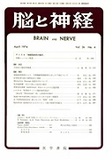Japanese
English
- 有料閲覧
- Abstract 文献概要
- 1ページ目 Look Inside
I.文献の展望
排尿に際して失神する症例の報告は,Haldane11)によれば,Rugg-Gunn (1946)の3例が最初のものであるという。10年後に,Gastaut6)が40例をまとめて報告し,その後,Proudfit & Forteza19)がmicturition syncopeと名付けて報告するにおよび,つぎつぎと,症例の報告とともに発現機序に関して種々の考察が行なわれてきた。Gastaut6)は,本態をvasovagal syncopeとし,発生機序としては,二元論的立場を取り,Aschnerの試験が陽性であるような副交感神経系優位の体質の個体で,夜間であること,膀胱が充満すること,排尿といつた更に副交感神経系を緊張させる機転が働き,これに加えて,夜間就眠時の血管緊張低下による起立性低血圧が関与して失神するとした。
Wayne28)は,510例の失神症例を分析し,17例のmi—cturition syncopeを挙げ,糖尿病や動脈硬化を伴わない,特殊な起立性低血圧症として説明した。しかし,単なる起立性低血圧のみで起こり得ないことは,Cogginsら1),Lukashら15),Donkerら3)の症例での誘発試験でも明らかである。
Forty seven cases of micturition syncope were reported. Only one of them was female. As to six cases of them, the syncope after the micturition was considered to be a partial symptom of the definite disease; circulatory insufficieny of the bilateral anterior cerebral arteries, Shy-Drager's syndrome, spontaneous subarachnoid hemorrhage, cerebral glioblastoma, frontal convexity menin-gioma and so-called hysteroepilepsy. These six cases were divided from the main group in which only the micturition syncope itself comes into question as an abnormality. Furthermore, another group of six cases were reported, in which the syncope occurred without micturition. The syn-cope of these cases was considered possibly due to the similar mechanisms to the micturition syncope.
Symptoms and signs of forty one cases of mic-turition syncope were analysed and debated on. The typical attack occurred on voiding in the standing position. However, it may occur under some combination of such conditions as vagotonic constitution, fatigue or unfavorable condition, re-laxation, nighttime, drinking spirits, warmth, ly-ing, sleep, full bladder etc. But each of them are not always a necessary condition.
Pharmacological examination of the vegetative nervous systems was performed in only eight pa-tients. In three cases of them, it was interpretedthat every vegetative nervous system was unstable; sensitive to adrenalin, pilocarpine & atropine. In four cases of them, it was interpreted that every vegetative nervous system was hypertonic; sensi-tive to adrenalin & pilocarpine. In only one case, it was interpreted as vagotonic; sensitive to only pilocarpine. All of the eight cases were sensitive at least to the pilocarpine. As to mecholyl test, seven of the eight cases were normal type, and only one was parasympathetic. In thirteen cases, Aschner's test, carotid sinus reflex and Valsalva's maneuver were examined. As to Aschner's test, eight cases-61.5 per cent-were positive. As to carotid sinus reflex, seven cases-53. 8 per cent-were positive. No syncope was produced by Valsalva's maneuver in any of the thirteen cases. Trial of provocation was performed in four cases. Two of the patients were made to void in the standing position after distending the bladder with saline solution and three of them were made to void in the standing position after drinking and sleeping. We were never able to provoke attacks. It was supposed that mental tension suppressed the occurrence of attack.
Reviewing both the previous reports and inves-tigation of our cases, it was concluded that the essential of the micturition syncope is so-called vaso-vagal reaction triggered by voiding in the standing position under special circumstances. The conditions described above may presumably make the body vagotonic, and the peripheral vascular resistance lower. However, the precise mechanisms, in which the micturition works as trigger to evoke the vaso-vagal reaction, are unknown.
Most patients of the micturition syncope visitedour clinic for the examination of head injury following the syncope. Only one was classified as cerebral contusion or group III after Araki. All of the other cases were classified as concussion or group II after Araki. Loss of consciousness for several minutes to several hours was observed in those cases without sequential cerebral lesion. In four cases, linear fractures were detected on plain craniograms. In one case, diastasis of the suture was revealed. Traumatic subarachnoid hem-orrhage was verified in four cases. In one case, tonic convulsion was observed immediately after the trauma. With regard to the posttraumatic sequelae, twenty one patients complained of head-ache, head heaviness, suboccipital tenderness, nuchal pain, stiffness of the nape & shoulders etc. for several months to several years, which may be diagnosed as so-called great occipital-trigeminus syndrome or muscle contraction headache. In one case, bilateral anosmia was found. In one case, chronic subdural hematoma developed and opera-tion was performed.
For the cases with frequent attacks, some pro-phylactic trials were recommended; voiding fre-quently to avoid full bladder when drinking spirits, and keeping the sitting position for several minitues before standing up for urination at night. In some patients administration of Bellergal ? was tried for prophylaxis. Those prophylactic methods seemed to be effective for some cases.

Copyright © 1974, Igaku-Shoin Ltd. All rights reserved.


